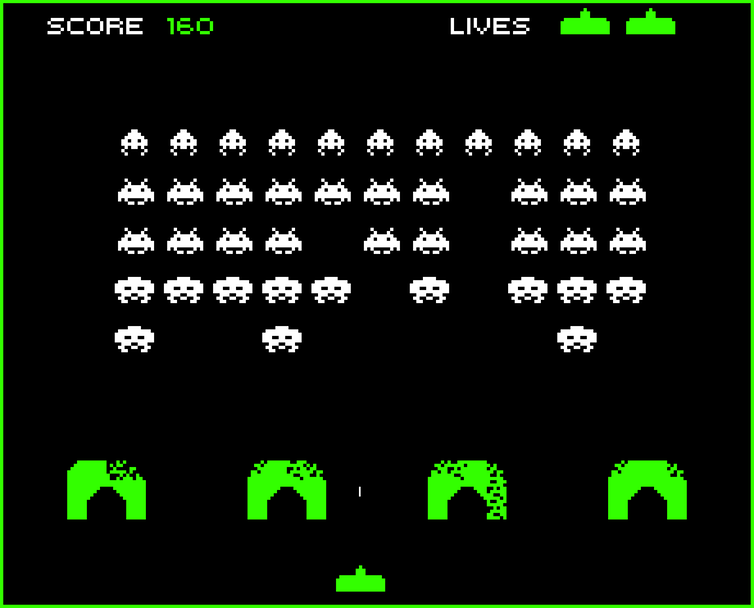Space Invaders of 1978 is a shooting game where the player defends against an array of advancing alien enemies, moving along a single axis and restricted to a single screen. The game single-handedly defined the genre of fixed shooters. In hindsight, these seem like arbitrary restrictions imposed by technical limitations of early gaming consoles. However, if we examine the game space more closely, it is fascinating how so many complex strategic considerations emerged as a result of its simplicity.
Shooting is the main mechanic of the game. Its unidirectionality is what separates Space Invaders from others in its genre. The player is only able to shoot upwards, and see their bullets travel up to a certain distance until they disappear at the edge of the screen. The gameplay significance here is the travel time of bullets, manifesting in two strategic considerations. As the enemies appear on top of the screen, there is significant travel time for the bullets. Thus, the player must plan their shots early and expect the bullet to lag behind as the aliens move orthogonally on the screen. Another consideration is whether or not to wait for the enemies to advance. The longer the player waits to take their shots, the closer they get, and the easier it is to shoot with the reduced travel time. On the flipside, shots from enemies also take less time to travel to the player, shortening their reaction time. Besides, the player would be under a lot more time pressure to eliminate the wave before they breach the line, leading to a game-over. This is an ingenious design using concepts of limited interactable space, shared between the player and the enemies. Space Invaders cleverly places the player and the aliens on two sides of the screen, establishing a spatial opposition between the two factions. As the game progresses, the enemies spawn progressively closer to the player, pushing their space closer to the player’s, and urging them to adopt different strategies for each wave. To reach a winning condition the player has to make a trade-off, which in some way could be mitigated with skills, leading to multiple strategies.

Movement is another way the player interfaces with interactable spaces. In Space Invaders, the screen does not move like in later arcade games. This, again, is due to the limitations of the hardware system at the time, though the game plays this to its advantage. Enemies in Space Invaders move horizontally, while boss enemies (who give more points) shift from left to right. The player is faster than both of these types, giving room to outmaneuver them and plan ahead. The regular enemies also switch directions when they hit either side of the screen, which, alongside the random fire rate, makes corners of the rooms safer places for the player. You can barely get hurt at the edges. The game further expands on safe spaces with the barricades. They are a set of four objects the player can take shelter behind, though only temporarily. These barricades create points of interest behind them—places the player returns to from time to time, taking refuge from the enemy firing, or simply planning for their next move. There is surprising depth in the design of navigable space in Space Invaders.
Modern games and designers are too often fascinated with the intricacy and complexity of their game mechanics, piling on layers upon layers of player interactivity. Not only does this create a steep learning curve, but it also makes the act of playing a chore. In the terms of systems theory, their practice exponentiates the information processed by the player at each moment. Space Invaders, one of the earliest video games, uses the concepts of interactable spaces alone to make for a compelling gameplay experience. It demonstrates in simple and concrete terms that even the most rudimentary mechanics can spawn complex and ingenious strategizing by the player.
